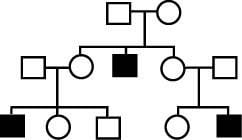If you’re preparing for the United States Medical Licensing Examination® (USMLE®) Step 1 exam, you might want to know which questions are most often missed by test-prep takers. Check out this example from Kaplan Medical, and read an expert explanation of the answer. Also check out all posts in this series.
This month’s stumper
A 5-year old boy (III-1) of Turkish descent is brought to his physician because of yellowness in his eyes. The patient's mother explains that this appeared after taking a long-term antibiotic that the physician prescribed for his severe chest infection. The physician performs a detailed analysis of his family (shown in the pedigree) that includes relatives who the mother knows have become ill when given the same antibiotic.
Which of the following is the most likely diagnosis?
A. Glucose-6-phosphate dehydrogenase deficiency.
B. Leber hereditary optic neuropathy.
C. Neurofibromatosis.
D. Sickle cell anemia.
E. Tay Sachs disease.
The correct answer is A.
Kaplan Medical explains why
The pedigree is most consistent with X-linked recessive inheritance. Glucose-6-phosphate dehydrogenase (G6PD) deficiency is the only X-linked recessive disorder listed and is consistent with the clinical aspects described in the patient. The yellowness of the eyes is the jaundice resulting from administration of a long-term antibiotic that can cause hemolytic episodes.
The hallmark of X-linked recessive inheritance is an abundance of affected males and an absence of affected females. Males are hemizygous for the X chromosome, so the phenotype is expressed with only one copy of the defective gene. Females have two copies of the X chromosome, so they appear phenotypically normal although they may be a carrier for the recessive allele. Since males inherit their X chromosome from their mother, she must carry the trait (or be affected by the disease). Affected males cannot pass the disease to male offspring. Other X-linked recessive diseases include Lesch-Nyhan disease, hemophilia A, and Duchenne muscular dystrophy.
Why the other answers are wrong
Choice B: Leber hereditary optic neuropathy is a relatively common cause of acute or subacute vision loss, especially in young men. It exhibits a mitochondrial inheritance pattern. The hallmark of this pattern is matrilineal inheritance - inheritance of affected genes from the mother. All of the children of an affected woman will be affected since they receive mitochondrial DNA from the female parent almost exclusively. Affected males do not contribute mitochondria to progeny, so their children will not receive the trait. The pedigree for a mitochondrial disorder would show an affected mother with affected children. The affected female children will have affected progeny while the affected male children will have normal progeny (assuming their mate is unaffected).
Choice C: Neurofibromatosis shows an autosomal dominant inheritance pattern, so the phenotype will be expressed if one mutant allele is present. Deleterious autosomal dominants occur at very low frequencies, so affected individuals are almost always heterozygous for the trait. Since the gene is located on an autosome, both male and female progeny can be affected and affected persons are expected in every generation. Other autosomal dominant diseases include Ehlers-Danlos syndrome, Huntington disease, and osteogenesis imperfecta.
Choice D and E: Sickle cell anemia and Tay Sachs disease are both show inherited in autosomal recessive manners. For the phenotype of the autosomal recessive to be expressed, the recessive allele must be present in both alleles. Both male and female children can be affected. The pedigree would be expected to show both males and females equally affected and the tendency to skip generations. Consanguinity is commonly see in families with autosomal recessive disease.
Tips to remember
Glucose-6-phosphate dehydrogenase deficiency:
- X-linked recessive disorders predominantly affect males because males are hemizygous for the X chromosome.
- Affected males inherit the mutant allele from their mothers.
- Affected males pass the mutant allele to all daughters, who are carriers, but to none of their sons.
- G6PD deficiency, hemophilia A, and Duchenne muscular dystrophy are examples of X-linked recessive diseases that are commonly tested.
For more prep questions on USMLE Steps 1, 2 and 3, view other posts in this series.
The AMA and Kaplan have teamed up to support you in reaching your goal of passing the USMLE® or COMLEX-USA®. If you're looking for additional resources, Kaplan provides free access to tools for pre-clinical studies, including Kaplan’s Lecture Notes series, Integrated Vignettes, Shelf Prep and more.




